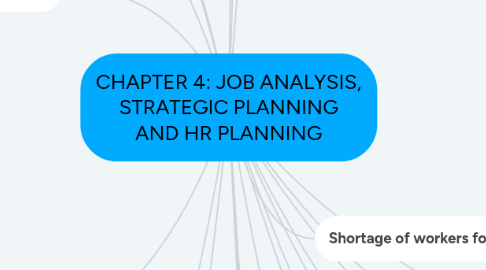
1. Types of job analysis information
1.1. identify job's actual duties + responsibilities + gathers other types of data: work activities, worker-oriented activities, machines, tools, equipment, work aids used, personal requirements
1.2. job-related tangibles + intangibles: knowledge needed, materials processed, good made, sevices performed
1.3. job analysis methods
1.3.1. questionnaires
1.3.1.1. administer a structured questionnaire to employees
1.3.2. observation
1.3.2.1. watching workers perform job tasks + record their obsevation
1.3.3. interviews
1.3.3.1. interviewing employees 1st ==> helping them describe the duties performed
1.3.3.2. interviewing supervisors 2nd ==> check accuracy of the information obtained form employees
1.3.4. employee recording
1.3.4.1. employees describe their daily work activities in a diary or log
1.3.5. combination of methods
2. Conducting job analysis
2.1. should include employees + employees' supervisors
2.2. organizations lack technical expertise may use outside consultants
3. Job description
3.1. provide concise statements of what employees are expected to do on the job + how they do + conditions
3.1.1. major duties performed
3.1.2. percentage of time devoted to each duty
3.1.3. performance standards to be achieved
3.1.4. working conditions + possible hazards
3.1.5. number of employees performing jobs + to whom they report
3.1.6. machines + equipment used on job
3.2. job identification
3.2.1. include: job title, department, reporting relationship, job number, code
3.3. date of job analysis
3.3.1. placing on job description ==> identify job changes, would make the description obsolete
3.4. job summary
3.4.1. providing a concise overview of job
3.5. duties performed
3.6. job specification
4. Job analysis for team members
5. Job analysis and Law
6. HR as a strategic business partner
7. Strategic Planning process
7.1. mission determination
7.1.1. unit's continuing purpose or reason for being
7.2. environmental assessment
7.3. objective setting
7.4. strategy setting
7.5. strategy implemantation
7.6. process by top manager determines overall organizational purposes + objectives + how they are achieved
8. Job analysis: A basic HRM tool
8.1. is the systematic process of determining skills, duties, knowledge required for performing jobs in an organization
8.2. the tasks needed to perform the job are identified
8.3. job: group of tasks performing for an organization ==> achieve goals
8.4. position: the collection of tasks + responsibilities performed by 1 person
8.5. purpose: to obtain answers to 6 questions
8.5.1. 1. what physical and mental tasks does the worker accomplish?
8.5.2. 2. when is the job to be completed?
8.5.3. 3. where is the job to be accomplished?
8.5.4. 4. how does the worker do the job?
8.5.5. 5. why is the job done?
8.5.6. 6. what qualifications are needed to perform the job?
8.6. performed on 3 occasions
8.6.1. 1. when the organization is founded + job analysis program is initiated for 1st time
8.6.2. 2. when new job is created
8.6.3. 3. when jobs are changed significantly as a result of new technologies, methods, procedures, systems,..
8.7. job description: provide information regarding the essential tasks, duties, responsibilities
8.8. job specification: outlines the minimum acceptable qualifications a person should possess to perform a particular job
9. Reasons for Conducting Job Analysis
9.1. Staffing
9.2. Training and Development
9.3. Performance Appraisal
9.4. Compension
9.5. Safety and Health
9.6. Employee and labor relations
9.7. Legal considerations
10. Standard Occupational Classification (SOC): based on actual changes in nature or organization of work activities being performed
11. HR Planning
11.1. systematic process of matching internal + external supply of people with job opening anticipated in the organization over specified period of time
11.2. requirement forecast: determining number, skill, location of employees the organization will need at future dates in order to meet goals
11.3. availability forecast: determination of if the firm will be able to secure employees with the necessary skills + from what sources
12. Forcasting HR Requirements
12.1. zero-base forecast: forecasting method that uses current level of employment as starting point for determining future staffing needs
12.2. bottom-up forecast: in which each successive level, starting with the lowest, forecasts its requirements, ultimately providing aggregate forecast of employees needed
13. HR Databse: containing employees information that permits management to make HR decisions
14. Shortage of workers forecasted
14.1. innovative recruiting
14.1.1. recruiting in different geographic areas
14.1.2. exploring new methods
14.1.3. seeking different kinds of candidates
